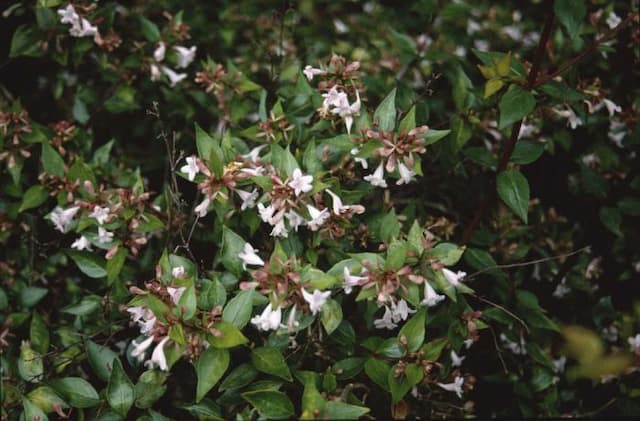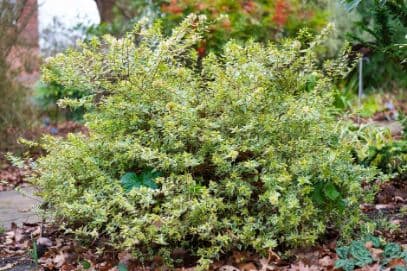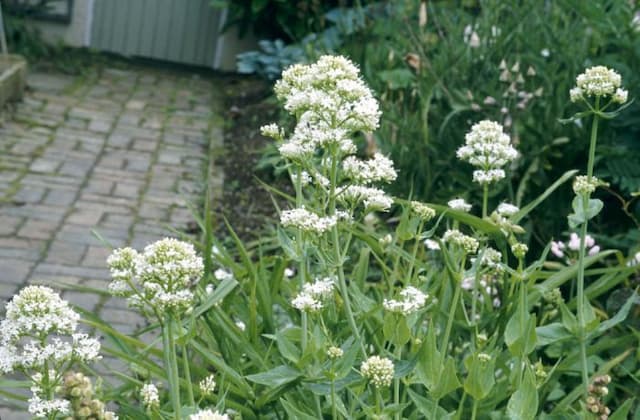Abelia 'Kaleidoscope' Abelia × grandiflora 'Kaleidoscope' (PBR) (v)

ABOUT
'Kaleidoscope' is a dwarf, variegated shrub that bears pink-tinted, white, fragrant flowers in summer and autumn. The foliage colours of yellow and green deepen as the season progresses taking on a orange and red hue in autumn. Will prove semi-evergreen, rather than evergreen, in colder spots
About this plant
 Names
NamesFamily
Caprifoliaceae
Synonyms
Kaleidoscope Abelia, Glossy Abelia
Common names
Abelia × grandiflora 'Kaleidoscope' (PBR) (v).
 Characteristics
CharacteristicsLife cycle
Perennials
Foliage type
Evergreen
Color of leaves
Variegated
Flower color
White
Height
2-3 feet (0.6-0.9 meters)
Spread
3-4 feet (0.9-1.2 meters)
Plant type
Shrub
Hardiness zones
6
Native area
Mexico China
Benefits
 General Benefits
General Benefits- Versatile Planting Options - Abelia 'Kaleidoscope' can be used in a variety of landscape designs, including borders, container gardens, and as a ground cover.
- Aesthetic Appeal - It provides year-round interest with its changing foliage from bright yellow in spring, turning greenish-yellow in summer, to orange-pink in fall, and colorful stems in winter.
- Attracts Pollinators - The fragrant flowers attract butterflies and other beneficial pollinators to the garden.
- Low Maintenance - This plant requires minimal care once established, with occasional pruning to maintain shape and promote bushier growth.
- Drought Tolerance - Once established, it is quite drought-tolerant, making it suitable for xeriscaping and gardens in drier climates.
- Deer Resistant - Typically resistant to deer browsing, which makes it an excellent choice for areas with high deer populations.
- Compact Growth - With a compact growth habit, it is suitable for small gardens or spaces where a non-invasive plant is needed.
 Medical Properties
Medical PropertiesThis plant is not used for medical purposes.
 Air-purifying Qualities
Air-purifying QualitiesThis plant is not specifically known for air purifying qualities.
 Other Uses
Other Uses- The variegated foliage of Abelia 'Kaleidoscope' can be used to create eye-catching floral arrangements, adding a splash of color and texture to bouquets.
- Crafted into topiaries or shaped forms, Abelia 'Kaleidoscope' can serve as a living sculpture in formal gardens or as decorative elements for special events.
- The compact size of Abelia 'Kaleidoscope' makes it ideal for bonsai, offering a unique variation from more traditional bonsai plant choices.
- Its dense growth habit can be utilized for creating intricate garden mazes or low-lying garden dividers that change color throughout the seasons.
- Abelia 'Kaleidoscope' can be planted in hanging baskets, allowing its colorful foliage to cascade over the sides for a stunning visual display.
- Photographers sometimes use this plant as a natural backdrop for portrait and macro photography due to its variegated leaves and small flowers.
- Gardeners can take advantage of the plant's changing hues to create a garden calendar, noting the color transitions to track the seasons.
- The plant's resistance to deer makes it a suitable option for borders around vegetable gardens or areas where deer browsing is a problem.
- Leaves of Abelia 'Kaleidoscope' can be used in craft projects, such as pressing for herbarium collections or card making due to their varied coloring.
- The stems with leaves and flowers of Abelia 'Kaleidoscope' can be used as natural dyes for fabrics, yielding subtle hues unique to the plant's pigmentation.
Interesting Facts
 Feng Shui
Feng ShuiAbelia is not used in Feng Shui practice.
 Zodiac Sign Compitability
Zodiac Sign CompitabilityAbelia is not used in astrology practice.
 Plant Symbolism
Plant Symbolism- Adaptability: The 'Kaleidoscope' variety of Abelia is known for its changing colors through the seasons, representing the ability to adapt and thrive through different conditions.
- Diversity: Its multicolored foliage, which offers a variety of colors in just one plant, symbolizes diversity and variety in life.
- Enthusiasm: With its vigorous growth and prolific blooms, Abelia 'Kaleidoscope' reflects an enthusiasm for life and constant growth.
- Renewal: As this plant transitions from one color to another with the passing seasons, it is often associated with renewal and the cyclic nature of life.
 Water
WaterKaleidoscope Abelia should be watered deeply once a week, providing about 1 inch of water each time, which equals approximately 0.623 gallons for an average-sized plant. During the growing season in spring and summer, it may require more frequent watering, especially in hotter, drier climates. Always check the soil moisture before watering; it should be moist but not waterlogged. Cut back on water during the winter months when the plant is not actively growing, watering only when the soil is dry to the touch a few inches down.
 Light
LightKaleidoscope Abelia thrives best in full sun to partial shade conditions. It prefers a location where it can receive at least 6 hours of direct sunlight each day, but it can also tolerate some shade, especially from the hot afternoon sun. An east or west-facing spot is ideal to provide the optimal light balance for vigorous growth and best foliage color.
 Temperature
TemperatureKaleidoscope Abelia is hardy and can withstand temperatures as low as 5°F and as high as 90°F, making it suitable for a wide range of climates. The ideal temperature range for this plant is between 60°F and 80°F. It will grow most vigorously and produce the most blooms within this temperature range.
 Pruning
PruningPruning Kaleidoscope Abelia is done primarily to maintain shape and encourage bushier growth. Prune in late winter or early spring before new growth begins. Trim back just enough to shape the plant and remove any damaged or dead branches. Additionally, light pruning in summer can help stimulate more flowering. A major prune every few years can rejuvenate an older plant.
 Cleaning
CleaningAs needed
 Soil
SoilKaleidoscope Abelia thrives in well-draining soil with a pH ranging from 5.5 to 7.5. A good soil mix for this plant would consist of two parts garden soil, one part sand, and one part organic compost to ensure proper drainage and nutrition. Mulching is also beneficial to retain moisture and suppress weeds.
 Repotting
RepottingKaleidoscope Abelia is typically grown in the ground and does not require repotting. However, if grown in containers, repotting every 2 to 3 years or when the roots outgrow the pot is advisable to ensure healthy growth.
 Humidity & Misting
Humidity & MistingKaleidoscope Abelia is adaptable to a range of humidity conditions, but it prefers moderate humidity levels. Although this shrub is quite resilient, extremely high humidity over long periods can lead to fungal issues, so ensuring good air circulation is beneficial.
 Suitable locations
Suitable locationsIndoor
Place in bright, indirect light, and ensure good air circulation.
Outdoor
Plant in sun to partial shade with shelter from harsh winds.
Hardiness zone
6-9 USDA
 Life cycle
Life cycleThe Kaleidoscope Abelia is a perennial shrub that begins its life as a seed or more commonly by cutting, which when planted, germinates or roots to form a new plant. Following initial establishment, it enters a vegetative stage where it develops a framework of stems and leaves and demonstrates its variegated foliage. As the plant matures, typically within 2-3 years, it begins the reproductive phase, flowering in the summer to late fall with small, tubular white to pinkish blooms that attract pollinators. After pollination, if successful, it may produce small, inconspicuous seed heads, although propagation is often achieved through cuttings rather than seed. During the winter, the plant may experience a period of dormancy, with reduced growth and minimal flowering, especially in cooler climates. Finally, as the Kaleidoscope Abelia ages, it can be prone to woodiness and may require pruning to rejuvenate growth and maintain its shape and colorful foliage.
 Propogation
PropogationPropogation time
Spring to Summer
Propogation: The most popular method of propagating Abelia 'Kaleidoscope' is through semi-hardwood cuttings. This is usually done in late summer or early fall when the current year’s growth has begun to harden but is not yet fully woody. Cut a 4 to 6-inch (approximately 10 to 15 cm) length of stem that has at least two or three sets of leaves. Remove the leaves from the lower half of the cutting and dip the cut end into a rooting hormone powder to encourage root development. Then, place the cuttings into a well-draining potting mix, ensuring that the leafless portion is buried. The pot should be kept moist, placed in indirect sunlight, and ideally maintained within a temperature range of 65-75°F (approximately 18-24°C). Roots typically develop within a few weeks to a couple of months, after which the new Abelia 'Kaleidoscope' plants can be transferred to individual pots or a suitable location in the garden.









